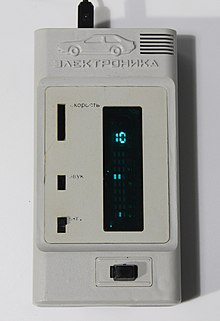
A handheld game console, or simply handheld console, is a small, portable self-contained video game console with a built-in screen, game controls and speakers. Handheld game consoles are smaller than home video game consoles and contain the console, screen, speakers, and controls in one unit, allowing players to carry them and play them at any time or place.

The Intellivision is a home video game console released by Mattel Electronics in 1979. The name is a portmanteau of "intelligent television". Development began in 1977, the same year as the launch of its main competitor, the Atari 2600. In 1984, Mattel sold its video game assets to a former Mattel Electronics executive and investors, eventually becoming INTV Corporation. Game development ran from 1978 to 1990, when the Intellivision was discontinued. From 1980 to 1983, more than 3.75 million consoles were sold. As per Intellivision Entertainment the final tally through 1990 is somewhere between 4.5 and 5 million consoles sold.
Battlestar Galactica is an American science fiction media franchise created by Glen A. Larson. It began with the original television series in 1978, and was followed by a short-run sequel series, Galactica 1980, a line of book adaptations, original novels, comic books, a board game, and video games. A reimagined version aired as a two-part, three-hour miniseries developed by Ronald D. Moore and David Eick in 2003, followed by a 2004 television series, which aired until 2009. A prequel series, Caprica, aired in 2010.

The WonderSwan is a handheld game console released in Japan by Bandai. It was developed by Gunpei Yokoi's company Koto Laboratory and Bandai, and was the last piece of hardware Yokoi developed before his death in 1997. Released in 1999 in the sixth generation of video game consoles, the WonderSwan and its two later models, the WonderSwan Color and SwanCrystal were officially supported until being discontinued by Bandai in 2003. During its lifespan, no variation of the WonderSwan was released outside of Japan.
Elektronika, also spelt Electronika and Electronica, is the brand name used for many different electronic products built by factories belonging to the Soviet Ministry of Electronic Industry, including calculators, electronic watches, portable games, and radios. Many Elektronika designs were the result of efforts by Soviet engineers, who were working for the Soviet military–industrial complex but were challenged with producing consumer goods that were in great shortage in the Soviet Union. The brand is still in use in Belarus.

Handheld electronic games are interactive electronic games, often miniaturized versions of video games, that are played on portable handheld devices, known as handheld game consoles, whose controls, display and speakers are all part of a single unit. Rather than a general-purpose screen made up of a grid of small pixels, they usually have custom displays designed to play one game. This simplicity means they can be made as small as a smartwatch, and sometimes are. The visual output of these games can range from a few small light bulbs or LED lights to calculator-like alphanumerical screens; later these were mostly displaced by liquid crystal and vacuum fluorescent display screens with detailed images and in the case of VFD games, color. Handhelds' popularity was at its peak from the late 1970s into the early 1990s before declining. They are the precursors to the handheld game console.

An electronic game is a game that uses electronics to create an interactive system with which a player can play. Video games are the most common form today, and for this reason the two terms are often used interchangeably. There are other common forms of electronic game including handheld electronic games, standalone systems, and exclusively non-visual products.
A dedicated console is a video game console that is limited to one or more built-in video game or games, and is not equipped for additional games that are distributed via ROM cartridges, discs, downloads or other digital media. Dedicated consoles were very popular in the first generation of video game consoles until they were gradually replaced by second-generation video game consoles that use ROM cartridges.

Battlestar Galactica is an American science fiction television series created by Glen A. Larson that aired on the ABC network from September 17, 1978, to April 29, 1979. It stars an ensemble cast led by Lorne Greene, Richard Hatch, and Dirk Benedict. The series follows a group of humans fleeing the destruction of their homeworlds aboard the titular spacecraft, searching for a new home while being pursued by the Cylons, a fearsome society of robots intent on exterminating all humans.

In the history of video games, the first generation era refers to the video games, video game consoles, and handheld video game consoles available from 1972 to 1983. Notable consoles of the first generation include the Odyssey series, the Atari Home Pong, the Coleco Telstar series and the Color TV-Game series. The generation ended with the Computer TV-Game in 1980 and its following discontinuation in 1983, but many manufacturers had left the market prior due to the market decline in the year of 1978 and the start of the second generation of video game consoles.

A ROM cartridge, usually referred to in context simply as a cartridge, cart, or card, is a replaceable part designed to be connected to a consumer electronics device such as a home computer, video game console or, to a lesser extent, electronic musical instruments.

Dungeons & Dragons Computer Fantasy Game is a handheld electronic game released by Mattel in 1981. Designer Peter Oliphant claims that it was one of the more basic projects he worked on during his career.

Auto Racing is a racing video game written by Larry Zwick and released by Mattel for its Intellivision video game console in 1980. Auto Racing pits two players against each other using a top-down perspective on one of five different race courses. Auto Racing was released under the same name by Sears for its private-label version of the Intellivision console, the Super Video Arcade.

Snafu is a video game released by Mattel for its Intellivision video game system in 1981. One of a number of snake games released in the late 1970s and early 1980s, Snafu features players controlling ever-lengthening serpents as they attempt to corner their opponents and trap them.

Galaxian 2 is a handheld electronic game that was released in 1981 in the US by Entex Industries. It was also released the same year in Japan under the name Astro Galaxy and in Europe under the name Astro Invader. The game was also released under the Futuretronics brand in Australia.
A vertically scrolling video game or vertical scroller is a video game in which the player views the field of play principally from a top-down perspective, while the background scrolls from the top of the screen to the bottom to create the illusion that the player character is moving in the game world.

Taito of Brazil was a pinball and arcade manufacturer located in São Paulo, Brazil. The company originally started out as Clover Electronic Amusement in 1968, then became Taito of Brazil in 1972 by Abraham "Abba" Kogan, the son of the founder of the parent company Taito located in Japan. This subsidiary was originally an importer of existing U.S. and Japanese machine components to be assembled within the country. However, the taxation on imports had been growing steadily, and the government's belief that pinball is a game of chance and considered a gambling machine, led to strict import rules. By 1976, within rules created by the Electronic Processing Activities Coordinating Committee (CAPRE), it became illegal to import pinball machines. This created a problem, since the popularity of arcade games in Brazil had been growing exponentially for many years.

Mark B. Lesser is an American game producer and electronic engineer, best known for programming the first handheld games from Mattel Electronics. He also developed several installments of the NHL video game series.

















